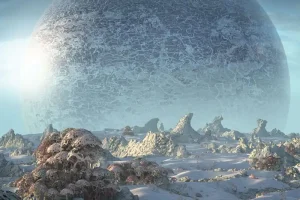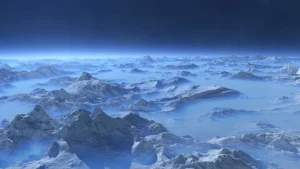Alien Ice Planets? The Mystery of Oumuamua and Other Interstellar Visitors

Introduction: The First Messenger from the Stars
In October 2017, astronomers detected something extraordinary — a mysterious, cigar-shaped object traveling through our solar system at incredible speed. This interstellar visitor, named ‘Oumuamua (Hawaiian for “scout” or “messenger”), was the first confirmed object from another star system ever observed passing through our cosmic neighborhood.
From the moment it was spotted, ‘Oumuamua defied explanation. It accelerated in ways that couldn’t be easily explained by gravity alone, didn’t produce a visible cometary tail, and had an unusual shape unlike anything seen before. Scientists and dreamers alike began to ask a provocative question: could this be an artifact of alien technology—or an “alien ice planet” that had wandered across galaxies?
To understand why ‘Oumuamua continues to captivate astronomers, we must look beyond the sensational headlines and dive deep into what we know—and don’t know—about interstellar visitors.
What Is ‘Oumuamua?
Discovered by the Pan-STARRS1 telescope in Hawaii, ‘Oumuamua was quickly identified as something unusual. Its orbit showed it was not bound by the Sun’s gravity, meaning it originated from beyond our solar system. This made it the first interstellar object ever observed entering and leaving our system.
Its trajectory, velocity, and tumbling motion suggested it had traveled for millions—or even billions—of years through interstellar space before reaching us. When it arrived, it was moving at around 87 kilometers per second, too fast to have originated from within the solar system.
At first, astronomers thought it might be a comet, but no coma or tail was visible. Others suggested it was an asteroid, yet its unusual motion didn’t match any known asteroid behavior.
For more on the discovery and initial analysis, you can explore NASA’s Oumuamua Overview.
Why ‘Oumuamua Was So Different
‘Oumuamua’s elongated shape — possibly 400 meters long but only a fraction as wide — made it unique. Some astronomers described it as a “cosmic pancake,” others as a “cigar,” though even those comparisons fall short. The object also reflected sunlight in irregular ways, indicating a highly polished or metallic surface.
But what truly baffled scientists was its acceleration. As it left the Sun’s gravitational influence, ‘Oumuamua sped up slightly, something typical for comets when ices sublimate and release gas. However, no gas or dust emissions were detected, which should have been visible with modern instruments.
That left researchers with a mystery: how could something accelerate like a comet but show no cometary activity? This puzzling behavior sparked new theories — some of them grounded in astrophysics, and others that ventured into the realm of the extraordinary.
Scientific Theories and Hypotheses
Several hypotheses emerged to explain ‘Oumuamua’s unusual characteristics:
- Hydrogen Iceberg Theory: Some scientists proposed that ‘Oumuamua was composed primarily of molecular hydrogen ice, which could sublimate invisibly in sunlight, causing acceleration without a visible tail.
- Cosmic Dust Aggregate: Others argued it might be a “fractal dust aggregate,” an extremely porous, lightweight object that could be pushed by solar radiation pressure.
- Nitrogen Ice Fragment: A team from Arizona suggested it could be a chunk of nitrogen ice ejected from a Pluto-like planet in another star system, slowly eroding as it traveled through space.
Each explanation tried to fit the data but also carried problems. Hydrogen and nitrogen ice, for instance, would likely have evaporated long before reaching our solar system after millions of years in interstellar space.
The Debate About Alien Origins
The idea that ‘Oumuamua might be of artificial origin gained traction when Harvard astrophysicist Avi Loeb suggested it could be a “light sail” — a thin, reflective structure propelled by starlight, possibly created by an alien civilization.
Loeb’s hypothesis, published in The Astrophysical Journal Letters, stirred massive debate. Critics argued the evidence was too limited and that extraordinary claims require extraordinary proof. Still, the discussion reignited interest in searching for potential signs of extraterrestrial technology in astronomical data.
Projects like Breakthrough Listen even monitored ‘Oumuamua for potential radio emissions — none were found, but the precedent was set: interstellar objects could be potential “technosignatures.”
Other Interstellar Visitors: Borisov and Beyond
In 2019, another interstellar visitor was discovered:The Kuiper belt and its relation with Pluto – Our pluto Unlike ‘Oumuamua, this object clearly behaved like a comet, showing a visible tail and releasing gases. It provided a fascinating comparison—showing what a “typical” interstellar object might look like.
While Borisov appeared to be entirely natural, it confirmed that interstellar visitors are not rare anomalies but possibly common. This discovery encouraged scientists to prepare for future detections and study the chemistry of these cosmic travelers in detail.
Technological Search and Future Observations
Advances in telescope technology have made it possible to spot such fleeting visitors. The upcoming Vera C. Rubin Observatory in Chile is expected to detect many more interstellar objects once it begins full operations. Its vast field of view and automated scanning system will revolutionize how quickly astronomers can identify and track fast-moving bodies.
Space agencies are also considering direct missions. The European Space Agency (ESA) has proposed the Comet Interceptor Mission, designed to rendezvous with a long-period or interstellar object. Meanwhile, private groups like Project Lyra explore the possibility of sending a spacecraft to intercept the next interstellar visitor.
Interstellar Mysteries and Ice Planets
Could ‘Oumuamua and objects like it be fragments of larger “alien ice planets”? It’s a compelling idea. If other planetary systems experience collisions or ejections, chunks of icy worlds could be thrown into deep space, wandering for eons before crossing our path.
These interstellar “ice fragments” might carry the chemical fingerprints of their parent systems, offering clues to planetary formation across the galaxy. Studying them could help scientists understand whether life-essential elements like carbon and water are widespread throughout the cosmos.
The possibility that these are remnants of habitable zones or exoplanetary oceans makes the search even more tantalizing. Every interstellar object could be a frozen time capsule from another world.
Future Missions and What We Might Discover
Future missions aim to capture unprecedented data about interstellar objects. Hypothetical spacecraft could use advanced propulsion to reach them quickly, analyzing their composition and possibly bringing back microscopic samples. This would mark a new frontier in space exploration—literally bringing the galaxy to our doorstep.
Scientists hope that in the next two decades, we might catalog dozens or even hundreds of interstellar visitors. Each discovery will refine our understanding of how matter moves between star systems, how planets form, and perhaps, how life could spread through panspermia—the idea that life’s building blocks can travel on cosmic debris.
Cosmic Messengers and Human Curiosity
‘Oumuamua reminded us of our cosmic smallness—and our boundless curiosity. Whether it was an alien ice planet, a shard of an exoplanet, or something even stranger, its visit opened humanity’s eyes to a larger universe full of motion and mystery.
The question remains: how many more of these messengers are out there? And what stories will they tell us about the birth of stars, the death of worlds, and the persistence of life in the void?
As technology advances, one thing is certain — we will not stop looking up, scanning the stars for the next unknown traveler that dares to cross into our solar system.
Si quieres conocer otros artículos parecidos a Alien Ice Planets? The Mystery of Oumuamua and Other Interstellar Visitors puedes visitar la categoría Solar System.

